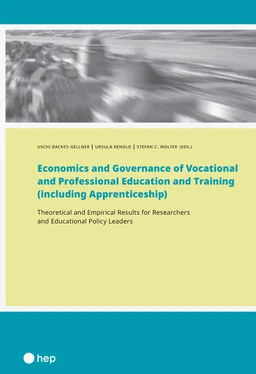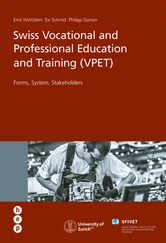To uncover the main functions behind a strong VET program, one must identify functional equivalents as the solution to cross-sectional comparison challenges and identify their socially constructed concepts. Summarizing the literature of different disciplines, I provide an analytical tool to identify functional equivalents and provide examples from the education and training sector.
Vocational Education and Training (VET)[2] is a global educational policy issue (OECD, 2015; UNESCO, 2015; CEDEFOP, 2018). Technological change, globalization, and social acceleration (Rosa, 2003, 2016; Lorenz-Spreen et al., 2019) are driving skills changes and leading to the constant adaptation of educational concepts (Autor et al., 2003). Furthermore, transferrable competencies such as problem solving, working under time and cost pressure, teamwork or independent work are becoming more important relative to hard skills (Trilling & Fadel, 2009; Salvisberg, 2010; Bolli & Renold, 2017). Reform leaders and policy-makers see their education and training system as being one-sidedly oriented by offering too many general and academic programs that are not compatible with new requirements for tomorrow’s working world. Academic education has attained a blurred meaning due to mass universities and the fact that the distinction between functions such as academic (i.e., research-oriented) activities and career-oriented education has become fuzzy ( Renold, 2015). Skills mismatch, over-qualification or underemployment (ILO, 2014; Livingstone, 2009) are consequences of such developments. Direct entry into the labor market is difficult for many university graduates without several internships; they first have to acquire the competencies and work experience they lack (Stolz, 2005).
Such causes have placed VET in the focus of policy debates. Concepts such as work-oriented curricula, learning places beyond schools, and more complex institutional governance, including actors from the employment system, are seen as suitable solutions for a smoother transition from education to employment (OECD, 2010; CEDEFOP, 2018). Switzerland, Germany, Austria, and Denmark act as model countries due to their high performance on the youth labor market ( Renold et al., 2014). Hence, foreign delegations visiting these countries are looking for solutions to improve their own education and training system, even though most of them know that one cannot transfer a concept from one country to another. Michael Sadler concluded as early as 1900 (Bereday, 1964) that
A national system of education is a living thing, the outcome of forgotten struggles and difficulties, and “of battles long ago”. It has in it some of the secret workings of national life. It reflects, while it seeks to remedy, the failings of the national character. By instinct, it often lays special emphasis on those parts of training which the national character particularly needs (p. 310).
That said, terms used in the national educational jargon, such as VET , apprenticeship , competences , skills , or knowledge are socially constructed and reflected by national norms and habits. Brockmann et al. (2009) provided an example for England, Germany, France, and the Netherlands. The authors analyzed the problem of introducing the European Qualification Framework (EQF) and proved that there is a variation in the key concepts that underpin the EQF. Brockmann et al. (2009) concluded that if concepts are culturally influenced, it is indispensable that international comparisons identify “transnational categories that take into account the social construction of terms such as skills and qualifications ” (p. 547).
This article provides a way forward for understanding socially constructed concepts by highlighting methodological problems in comparing countries’ education and training programs, shedding light on historically rooted concepts that may explain a certain configuration of institutions in social constructs, and explaining how readers can overcome such problems to compare apples with pears by working with classification frameworks and functional equivalents.
The chapter proceeds as follows: I continue in the second section by providing a brief explanation of what is meant by the social constructs and underline the theory with some examples. In the third section, to understand where socioeconomic and sociocultural differences may be rooted, I summarize the rival conception of VET in political economy theory and concepts of the variety of capitalism. The fourth section addresses the methodological problems of definitions, provides a classification scheme to overcome definition problems, and explains forms of construct metaphors discussed in the literature. The fifth section describes the importance of functional equivalents for comparing VET worldwide. Following Kohn (1989), a large problem in performing comparison is determining whether objects of knowledge and concepts are truly equivalent. Finally, I conclude by highlighting the importance of critically reflecting on the socially constructed concepts in reading research results from different scientific disciplines in the field of VET.
2.2 Social Constructs of What?
Berger and Luckmann (1967) pointed out in “The Social Construction of Reality” that social-cultural habits, histories, national characteristics, and institutions characterize the reality of life . Because the education system is part of reality , it is heavily influenced by those characteristics. Without well-founded knowledge of the institutions’ social construction in qualitative, spatial, and temporal circumstances ( Renold et al., 2019), it is very difficult to compare concepts in education and training systems. People must be aware of the fundamental problems (Turner, 1997) they want to solve and need a deep understanding of the social institutions ( Renold et al., 2019) that moderate those obstacles to find ways to improve education systems. Social institutions are a common pattern of behavior and shape the way goals can be achieved. They are driven by values, attitudes, habits, and incentive mechanisms. Following Social Constructs (2019),
Social constructs or social constructions define meanings, notions, or connotations that are assigned to objects and events in the environment and to people’s notions of their relationships to and interactions with these objects. In the domain of social constructionist thought, a social construct is an idea or notion that appears to be natural and obvious to people who accept it but may or may not represent reality, so it remains largely an invention or artifice of a given society (p. 1).
The social construct phenomenon may occur in this handbook because scientists from several disciplines have contributed. Depending on their epistemological and methodological approach, the used socially constructed concepts are more or less systematically explained. This handbook provides an overview of research results on the economics and management of VET from different perspectives. In general, the reader will look at concepts that aim to lead people into the labor market. Examples of such concepts are VET, apprenticeship, technical VET, career and technical education (CTE), or vocational training. Scholars often use these terms interchangeably. Sometimes these terms come from ordinary language or are simply translations from another language, but they do not necessarily match the concepts of the respective country. Behind such terms are socially constructed concepts that vary across countries. Without identifying functional equivalences (see Chapter 5), we run the risk of empirically comparing completely different concepts. Accordingly, it is difficult to adequately classify results and to recommend policy measures.
Читать дальше












